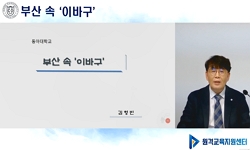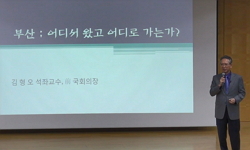Recently fine particle concentrations are generally regarded as one of the most concerns in most urban area in Korea. The objective of this study is to present an analysis of the PM10 (Particulate Matter with aerodynamic Diameter ≤10㎛) concentrati...
http://chineseinput.net/에서 pinyin(병음)방식으로 중국어를 변환할 수 있습니다.
변환된 중국어를 복사하여 사용하시면 됩니다.
- 中文 을 입력하시려면 zhongwen을 입력하시고 space를누르시면됩니다.
- 北京 을 입력하시려면 beijing을 입력하시고 space를 누르시면 됩니다.
지상 대기질 측정 자료를 이용한 대도시 2차 먼지 생성량 추정 = Estimation of Secondary PM10 Using Air Quality Data in Urban Area
한글로보기부가정보
다국어 초록 (Multilingual Abstract)
Recently fine particle concentrations are generally regarded as one of the most concerns in most urban area in Korea. The objective of this study is to present an analysis of the PM10 (Particulate Matter with aerodynamic Diameter ≤10㎛) concentrations in Busan in terms of the secondary aerosol formation. The interpretation of secondary PM10 from the observations is performed from both hourly monitored concentrations of PM10 in Busan and LPC(Laser Particle Counter) data obtained at Pusan National University, and the characteristics of secondary generated PM10 concentration was presented in accordance with the following three subsections.
1) Time variations (i.e., diurnal, weekly, monthly, and annual variations) from hourly observed concentrations of PM10 in Busan are analyzed for the period from 2000 to 2005, and the characteristics of aerosol second generation formation process is also inferrer from using the statistical analysis of the meteorological variables including temperature, wind speed, and relative humidity.
2) Particle volume and mass concentrations was calculated from LPC data obtained in Pusan National University, and analysis of size distribution is interpreted from the aspect of secondary aerosol formation.
3) Secondary PM10 concentrations and their diurnal variations was estimated in different photochemical activities from the observations of PM10, CO, and O3 concentrations obtained for the period from 2000 to 2006.
The result of variations shows some significant annual, seasonal, weekly and diurnal variations of PM10 concentrations. In particular, seasonal (i.e., spring season) variations are found to be governed by frequency of yellow sand events. In addition, seasonal variation is closely related to the precipitation, and weekly and diurnal variations are both reflecting the emission patterns. The correlation between PM10 concentration and meterological variables for non-yellow sand days show negative with visibility, wind speed, cloud amounts, and relative humidity, but positive correlation are found with relative humidity even for non-precipitation days. This is suggestive of the importance of secondary aerosol formation achieved by both homogeneous aerosol formation and heterogeneous transformations resulting from hygroscopic aerosol characteristics.
The results of analysis from LPC data show that 1) number distributions predominate in separated three distribution modes with the highest range of 0.3㎛ to 0.4㎛, 2) volume distribution with the highest value at about 3~4㎛, showing the dominant characteristics of oceanic aerosols size distribution presumably due to the sea salt particles. In comparison with the concentration distribution between summer vs. autumn, summer shows relatively higher than autumn by almost a factor of 2, implying that the secondary aerosol formation through photochemical reactions was largely contributed to the increasing aerosol concentrations.
Finally, in order to estimate the secondary PM10 concentrations at different photochemical activities from the observed PM10, CO, and O3 concentrations in Seoul and Busan for the period from 2000 to 2006, the photochemical activities was classified into three regimes on a daily basis, based on the difference in measured ozone concentration(i.e., maximum minus minimum; ΔO3,max-min) and the integral insolation (∫downward radiation) during the daytime. The ratio of CO vs. PM10 obtained at low photochemical activity regime was employed as an index of tracer for the isolation of the secondary PM10 at higher photochemical activity regimes. The results show that the estimated secondary PM10 concentrations for each of the two or three regimes according to bothΔO3,max-min and ∫downward radiation: (regime Ⅰ,ⅰ) - weak photochemical activity in Seoul and Busan, (regime II,ⅱ) - modern photochemical activity, respectively in Seoul, and Busan, and (regime Ⅲ, ⅲ) - strong activated photochemical activity in Seoul and Busan, respectively. The secondary generation PM10 is accounting for 22.2%~30.3% and 21.6%~29.1% of the total PM10 mass concentration in Seoul and Busan, respectively. Diurnal variation of secondary PM10 shows weak but noticeable patterns for the moderate photochemical regime under the photochemical range of regime I(or ⅰ) and II(or ⅱ). However, the highly activated photochemical regime (regime III, ⅲ) in Seoul shows strong diurnal variations of secondary PM10 concentrations with the high values in the afternoon. This is implying the importance of photochemical reaction and its contribution to the formation of secondary aerosol in both Seoul and Busan.
목차 (Table of Contents)
- 제1장 서론 = 1
- 1.1 연구 배경 = 1
- 1.2 연구 목적 = 4
- 제2장 자료 및 연구 방법 = 6
- 2.1 자료 = 6
- 제1장 서론 = 1
- 1.1 연구 배경 = 1
- 1.2 연구 목적 = 4
- 제2장 자료 및 연구 방법 = 6
- 2.1 자료 = 6
- 2.1.1 부산지역 미세먼지 농도 변화 경향 및 먼지 생성 특성 분석 = 6
- 2.1.2 부산대학교에서 측정된 에어로졸의 크기 분포와 특성 분석 = 8
- 2.1.3 지상 대기질 측정 자료를 이용한 서울과 부산지역의 2차 먼지 생성량 추정 = 10
- 2.2 연구 방법 = 12
- 2.2.1 부산지역 미세먼지 농도 변화 경향 및 먼지 생성 특성 분석 = 12
- 2.2.2 부산대학교에서 측정된 에어로졸의 크기 분포와 특성 분석 = 13
- 2.2.3 지상 대기질 측정 자료를 이용한 서울과 부산지역의 2차 먼지 생성량 추정 = 15
- 제3장 결과 및 분석 = 21
- 3.1 부산지역 미세먼지 농도 변화 경향 및 먼지 생성 특성 분석 = 21
- 3.1.1 부산지역의 PM10 농도 분석 = 21
- 3.1.2 PM10 농도와 국지 기상 변수와의 상관관계 = 28
- 3.2 부산대학교에서 측정된 에어로졸의 크기 분포와 특성 분석 = 35
- 3.3 지상 대기질 측정 자료를 이용한 서울과 부산지역의 2차 먼지 생성량 추정 = 42
- 3.3.1 CO와 PM10의 상관관계 및 일변화 특성 = 42
- 3.3.2 1차와 2차 PM10농도 추정 결과 = 53
- 제4장 요약 및 결론 = 64
- 4.1 부산지역 미세먼지 농도 변화 경향 및 먼지 생성 특성 분석 = 64
- 4.2 부산대학교에서 측정된 에어로졸의 크기 분포와 특성 분석 = 65
- 4.3 지상 대기질 측정 자료를 이용한 서울과 부산지역의 2차 먼지 생성량 추정 = 66
- 참고문헌 = 68
- Abstract = 74
- 감사의말 = 78












